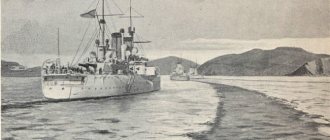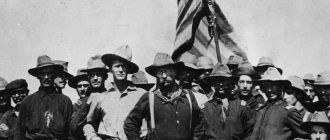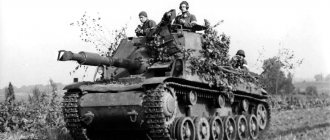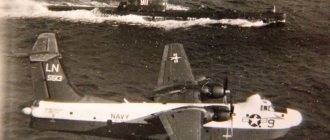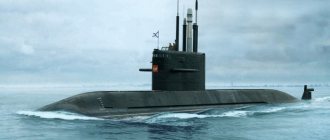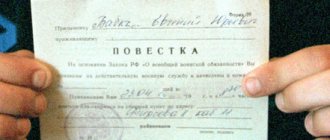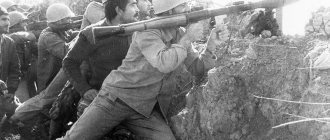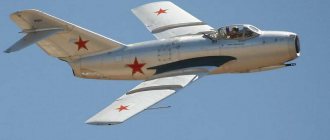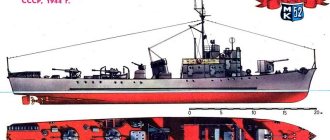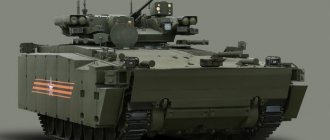Documentary films about weapons
With the end of World War II, the former allies in the anti-Hitler coalition no longer trusted each other. An arms race began, in which the main competitors were the USSR and the USA. Weapons designers produced “masterpieces” one after another. No one wanted or intended to give in to anyone.
8 films
Film 1. MiG-21 fighters against F-4 Phantom 2
The legendary aircraft of American carrier-based aviation, the Phantom F-4, appeared in the skies of Vietnam and had no equal. David Lewis, who led its development, could celebrate success. But an unexpected obstacle on the path to his triumph was the Soviet MiG-21 from the Mikoyan-Gurevich Design Bureau. What danger did this small plane pose to the heavy Phantom? What design solutions ensured the unprecedentedly long military service of both fighters - from the early 1960s to the present day? How did the MiG-21 end up being adopted by the US Air Force?
Film 2. Automatic weapons chambered for low-impulse cartridges. AK-74 vs M16
Since 1964, the American infantry in Vietnam has been re-equipped with M16 rifles of reduced caliber, lighter than previous models. How will Soviet gunsmiths respond? Will Mikhail Kalashnikov be able to extend the life of his assault rifle in competition with other models?
Film 3. Tu-95 versus B-52. Strategic bomber confrontation
The US Air Force B-52 strategic jet bomber was originally designed as a turboprop. What made American aircraft designers reconsider the project and equip this intercontinental aircraft with turbojet engines? And why, contrary to the direct instructions of Stalin, the Tupolev design bureau began developing not a jet, but a propeller-driven ultra-long-range bomber? What allows aircraft designed more than half a century ago to still be in service as carriers of nuclear weapons?
Film 4. Automatic sniper rifles. SVD vs M21
In the fast-paced battles of modern wars, it is important to shoot not only accurately, but also quickly. The US military installs an optical sight and bipod on the M14 rapid-fire rifle, then repeatedly improves it. How will the Soviet weapons school respond - by converting a regular army model into a sniper model, or by creating a special model? With whose rifles - American or Soviet - will snipers achieve better results in Vietnam and Afghanistan?
Film 5. Medium-range ballistic missiles. R-12, R-14 against PGM-17 Thor and "Jupiter"
In 1949, the Pentagon developed the Dropshot plan for a nuclear attack on the USSR. The main role in it was given to ultra-long-range bombers with atomic bombs on board. However, by that time the Soviet Union had already created weapons for a retaliatory strike. On September 1, 1949, the first Soviet atomic bomb was tested in the Pacific Ocean. And soon the first domestic ultra-long-range bomber TU-95 took wing. In the United States, the creator of the V-2 rocket, German designer Wernher von Braun, is involved in the rocket project. In the USSR, designer Sergei Korolev begins work on his own ballistic missiles. Soon other developers on both sides of the ocean will join the duel between Korolev and von Braun. How will this unprecedented battle of rocket designers end? And whose design solutions will be most effective?
Film 6. The first generation of nuclear submarines. Leninist Komsomol against Nautilus
The American nuclear submarine Nautilus was supposed to change the history of the combat fleet on a planetary scale. This is the world's first truly underwater warship - boats of previous generations spent most of their combat campaigns on the surface. Will Soviet gunsmiths be able to create their own nuclear-powered submarine in the shortest possible time? Why will the designation “Whale” be chosen for the new series of boats? Why did Lavrentiy Beria close the project to develop a submarine with a nuclear reactor? And why is the North Pole more important to a submariner than the Pacific and Atlantic oceans?
Film 7. Battle of the gunsmiths. Grenade launchers. RPG-7 vs M67
With a shot from a hand-held anti-tank grenade launcher, an infantryman can destroy an expensive tank along with its crew. But after the Korean War, it is obvious that all previous models of grenade launchers are outdated. Gunsmiths in the USA rely on increasing the caliber, while Soviet gunsmiths rely on mass production and ease of use by one soldier. About whose design ideas turned out to be more successful, whose weapons played a big role in numerous local conflicts of the last fifty years - in this film.
Film 8. Battle of the gunsmiths. T-62 tanks vs M60
Two mass-produced Soviet and American tanks - the Ural T-62 and M60A1 - embodied completely different design approaches. The Americans created a spacious and massive machine with a rifled gun. Soviet gunsmiths - compact and extremely easy to use, equipped with a smoothbore gun. These tanks would see action many times - in the Yom Kippur War, the Battle of the Ogaden and many other conflicts where it was not just armored vehicles that fought, but the ideas embodied in them. Which ones brought success?
Amazing weapons of World War II
During the Second World War, a lot of new weapons were invented, tested and used, some of which are still very famous. But there were also weapons that did not achieve the glory they deserved.
Below are some weapons you probably haven't heard of.
We will not talk about developments, but about directly used weapons
V-3
V-1, V-2 and V-3 (V-3 is also called “Centipede” and “English Cannon”) are Nazi projects under the general name “Weapons of Vengeance”. The V-3 was a huge artillery piece built on a hill and could, from France, bombard London across the English Channel. The gun had a total length of 124 m, and the gun barrel consisted of 32 sections with a length of 4.48 m; each section had two charging chambers located along the barrel and at an angle to it. During testing in May 1944, the gun showed a firing range of 88 kilometers, and during testing in July 1944, the projectile flight was 93 kilometers. Two V-3 guns were built, and only one of them was used in practice. From January 11 to February 22, 1945, approximately 183 rounds were fired. The target was Luxembourg, recently liberated from the Nazis. But the weapon only demonstrated its ineffectiveness. 143 shells reached the target, with which, fortunately, only 10 people were killed and 35 were wounded.
Super-heavy railway artillery guns "Dora" and "Gustav"
The Nazis definitely had an obsession with big guns. These two 807 mm guns were simply gigantic. And in fact, these were the largest guns in the world. Each of them could only be transported in parts, then they had to be assembled and installed on pre-prepared platforms - all these procedures required about 4,000 people. The Nazis deployed a full anti-aircraft regiment to protect the guns, and special forces protected them from partisans. Only "Gustav" was used in action. This gun fired 42 rounds during the siege of Sevastopol in 1942. The destructive power of his huge shells (each of which weighed 4800 kg) was enough to destroy an ammunition depot, which was protected by a 30-meter rock. There were plans to use rockets with this weapon, which could hit targets at a distance of 145 kilometers. Weapons expert Alexander Lüdecke called the guns a "technological masterpiece" but also said they were a "waste of manpower and materials."
Rat bombs
After France's surrender, Winston Churchill vowed to "set Europe on fire." After this, British special agents adopted various disguised explosive devices that would surprise even James Bond. The bombs were disguised as soap, shoes, bottles of wine, suitcases and even rats.
Yokosuka MXY7 Ohka
To increase the effectiveness of kamikazes, the Japanese launched the Ohka in 1944, a projectile aircraft flown by a suicide pilot. This jet, specially designed for kamikazes, was equipped with 1.2-ton warheads. These aircraft were transported by a Mitsubishi G4M bomber. When the target came within range, the Ohka would separate from the bomber, the pilot would fly as close to the target as possible, then fire the jet engines and crash into the designated target at great speed. The troops of the anti-Hitler coalition quickly learned to neutralize bombers before the projectile aircraft separated from them, which negated their effectiveness. But still, one case was recorded when Ohka sank an American destroyer.
Soviet anti-tank dogs
When our troops were in extremely difficult situations on the Eastern Front, we had to look for new and desperate means of combat - including the use of so-called anti-tank dogs. These dogs were specially trained to deliver a bomb to the desired target, activate it with their mouths and run back. Unfortunately, very rarely the dogs were able to correctly carry out the required tasks, so a more primitive strategy had to be used - simply blowing up the dogs. These suicide dogs were trained to find food at the bottom of the tank. Therefore, they were deliberately kept hungry, 12-kilogram bombs were tied to them and released on the necessary targets. They ran up to the tanks, trying to find food, unaware of their future fate. When the dog ran under the bottom of the tank, the bomb was activated by a fixed lever that struck the tank. Thus, the dogs performed their tasks quite effectively, so some Germans made it a habit to shoot at any dogs in sight. During the war, our army used about 40 thousand dogs to perform military tasks. According to undocumented estimates, about 300 enemy tanks were destroyed in this way.
Hobart's "Toys": In preparation for the Allied landings in Normandy, quite a lot of unusual equipment was developed, some of which were named after military expert Percy Hobart. Here are some examples of such equipment - Sherman Crab
AVRE Bobbin
AVRE Bridgelayer
Radio controlled bomb FritzXRuhustahlSD 1400
This bomb was intended to destroy heavily armored naval targets and was developed from the SD 1400 armor-piercing bomb, but featured improved aerodynamics, four 1.3-meter wings and a tail section. But the bomb had to be dropped directly over the target, which created an additional threat to the bomber. This was a very formidable weapon against the anti-Hitler coalition. On September 9, 1943, the Germans dropped several of these bombs on the battleship Roma, sinking it with 1,455 people on board. These bombs also sank the British cruiser Spartan, the destroyer Janus, the light cruiser Newfoundland and damaged many other ships. In total, about two thousand of these bombs were produced, but about 200 were used. The big problem was that the bombs could only fall strictly vertically, which created difficulties for the bombers, who suffered heavy losses.
Guided aerial bomb HenschelHs 293
This bomb was one of the most effective in World War II, and was used to sink and damage many destroyers and merchant ships. After the release, the rocket accelerator accelerated the bomb for 10 seconds, then the planning stage began towards the target, using radio command control. A beacon was installed on the bomb's tail so that the gunner could monitor its location and flight, both day and night. It was first used in August 1943, sinking the British sloop Egret. Towards the end of the war, the troops of the anti-Hitler coalition learned to intercept its radio frequencies and interfere with radio control, which significantly reduced the effectiveness of these bombs. Non-rotating projectiles This is one of those ideas that looks good on paper but turns out to be terrible in practice. Non-rotating shells were a British invention, anti-aircraft launchers that fired shells that burst in the air and released parachutes and wire with small bombs on the ends. The idea was to create a small air minefield. The plane caught on the wires, attracted bombs, and they exploded. The problem is that a strong wind could blow this trap away from the desired location (for example, back to the salvo installation itself). But despite this, this weapon was used quite widely in the first days of the war.
Midget submarines
These tiny four-person submarines, invented by the Italians, could sail distances of up to 2 thousand kilometers, dive to a depth of 100 meters and sail at speeds of up to 6 knots. The displacement of such submarines was only 30 tons. They only had one hatch, which created big problems in emergency situations.
Self-propelled mine "Goliath"
Such devices were first used by the Germans in 1942 to deliver 75-kilogram bombs to targets (most often tanks, dense concentrations of infantry, bridges or buildings). The wedge was controlled by wire at a distance and exploded when approaching the target. 4,600 of these self-propelled mines were manufactured, including an enlarged version that could carry 100-kilogram bombs. Unfortunately for the Germans, these devices were very slow, poorly controlled, and had a low carrying capacity. But this idea itself was clearly ahead of its time. “Goliaths” are a kind of predecessors of some modern robots, but at that time the technology for them was simply not sufficiently developed.
Source

